Loading Safety Means & Container loading - Safety belts to secure the goods
Cargo securing means securing the cargo (cargo) during transport via road, rail, air and ship traffic and the physical movement of forces which are occurring everywhere where transport security applies. These forces occur, for example in road transport when accelerating backwards, vertical in direction, during braking (inertia of mass), when driving through curves to the sides (vs. centrifugal force. Centripetal force) and on uneven roads (gravitation). Insufficient or misapplied and the lack of load security often leads to a load shifting.
Legal bases (as an example of road transportation in Germany)
According to § 22 of the Road Traffic Law in Germany(StVO) requires that load has to be packed and secured that even during an emergency braking or sudden evasive movement they can’t slip even under, fall down, roll around, fall down or produce avoidable noise. The codes of practice (such as VDI guidelines 2700 ff) has to be obeyed.
Responsible for a safe securing of the goods is the driver, owner and the shipper. Violations can (general traffic control or traffic accident with property damage) with administrative fines in the amount of 50 to 150 euros and 1 to 3 points will be punished in the traffic register in the offense. A criminal offense (eg traffic accidents involving personal injury) shall be punishable by fine or imprisonment.
The VDI guideline series VDI 2700 "Securing of loads on road vehicles" is known for many years and it is recognized as a foundational work of securing loads. In it describes what kind of forces acting on a load while driving and how the load /goods can be generally secured on vehicles. The guidelines are used for the monitoring of traffic police, but also to disputes in court.
Types of cargo securing
We distinguish two fundamentally different types of cargo securing:
- the frictional load securing and
- the positive load securing.
These two types of cargo securing can be combined.
Securing means
To secure loads following different lashing and tools can be used: pallets, lashing, lashing steel wire ropes, lashing chains, anti-slip mats, anti slip wood, wedges, edge protection, cargo nets, anchor channels in connection with loading and locking bars, lashing rails and other lashing, dunnage cushion or wooden dunnage.In Germany used to secure cargo lashings has to be marked at the loose end (the belt itself), as well as the fixed end (with belt tensioner / clutch). Normally you can find such a designation on a sewn sticker or on a labbel where the details of the security belt are printed on. Here are the details for SHF (standard hand force = normal hand strength), STF (Standard Tension Force = normal preload force), and LC (Lashing Capacity = acceptable force) to find, even the manufacturer, year of manufacture, the materials used and some more data. The color of the label, this phenomenon also information about the material from which the belt is made. Blue stands for polyester (PES), brown for polypropylene (PP), green for polyamide (PA) and white for other materials. The values are also printed on the transport authorities as well as customs and BAG on controls to calculate the friction forces reached.We speak with lashings of discard if they can no longer be used. This is the case if the label is missing or illegible, the belt yarn breaks or cuts which the belt is knotted, bearing seams are damaged or the belt through exposure to aggressive substances is useless. Even with a deformation of the clamping fasteners or the belt is to be discarded and must be replaced. Since lashings are stretchy due to the material characteristics to a certain degree, it may be necessary for longer trips, retighten the straps.In heavy duty lashing instead of lashing are mostly used safety chains especially in standing goods/load often not to be able tying down load must be filled in four positively located euro pallets.
Calculation of the prestressing force Fv or Stf when lashing.Fv = F μ / μ * Fg / 1.5 e.g. Fv = 0.8-0.2 / 0.2 * 2000/1, 5 = 4000
Source: URL:http://en.wikipedia.org/wiki/Load_securing / updated on the 20th of March 2013
Container loading safety belts:
Of course we have many international clients, who are organizing the transport via sea. The freight forwarder is providing the container, but it is the duty of the customer to ensure that the goods inside of the container are sufficient secured, therefore he has to provide us securing means before loading take place or to purchase them from us. We are ensuring that the goods are leaving our stock safely and secured packed via the belts given or purchased by the customer.
The security of the goods should also be in the interest of the customer itself, because he contracts the forwarding agency on his own account , thus he is also responsible and liable for the condition of the container (in case of damage) .
Picture of a damaged container:
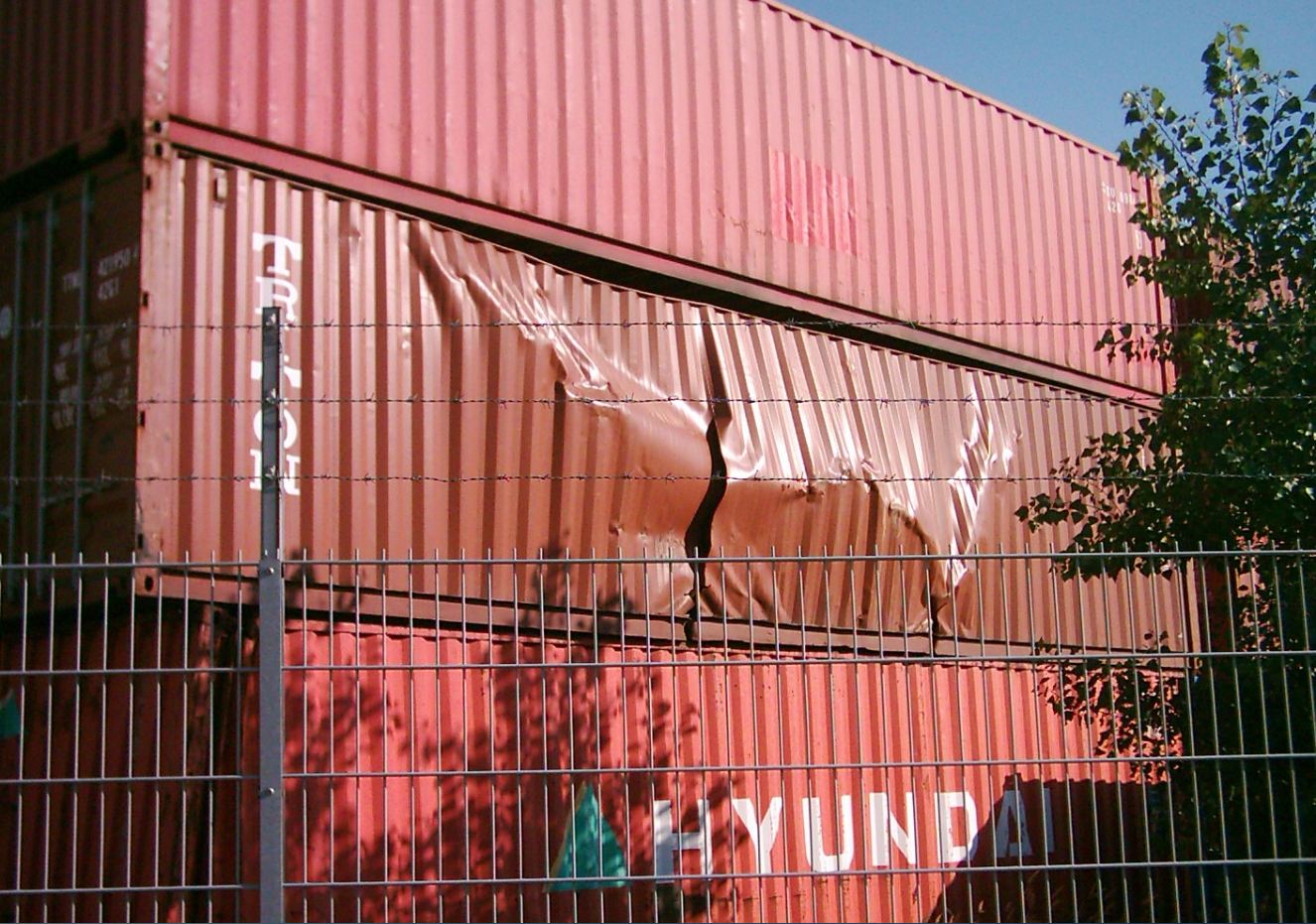
With the appropriate securing means this could have been avoided!
Furthermore it is possible through missing or misapplied securing of the goods inside of the container the goods can slip (weight shifting) and thus the container can fall down from its loading position. It is possible that if the container falls down it could drag other containers down and thus it could become an immense damage.
We are securing the goods via strapping them down on the container floor to prevent shifting during transportation via seaway.
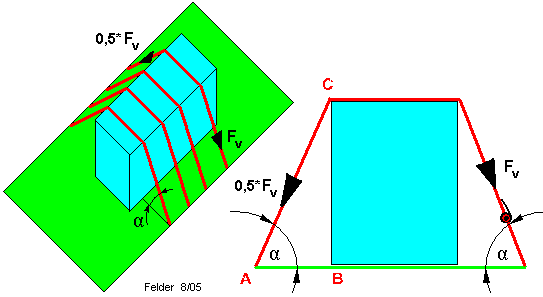
The figure shows the prestressing force FG and the lashing angle μ. If the lashing angle μ is 90 °, so the belt pulls down the load on the loading platform with exactly 1.5 times of its biasing force. When the lashing angle is
Coefficients of Friction Table
coefficient of sliding friction µ dry wet greasy
wood/ wood 0,20-0,50 0,20-0,25 0,05 – 0,15
metal / wood 0,20-0,50 0,20-0,25 0,02-0,10
metal/ metal 0,10-0,25 0,10-0,20 0,01-0,10
concrete/ wood 0,30 -0,60 0,30-0,50 0,10 -0,20
The coefficient of sliding friction will always been indicated of two materials which rub against each other. The chart does show different results depended from the material pairing and from the environmental conditions (dry, wet, greasy). The coefficient of sliding friction μ=0,2 means that one has to spend FR = 200 daN force in order to move a mass of m = 100kg with this coefficient of sliding friction on the loading platform (FR = μ * FG). Speaking about loading securing there is not used static friction, but sliding friction in order to take in account the vehicle vibrations. Is the sliding friction unknown you have insert in the formula μ = 0,2. If you use anti slip mats you have to consider μ = 0,6.
The complete formula in order to calculate the number of security belts is as following:
z = (0,8 * FG / μ - FG) / (1,5 * Fv * sinα) or pulling down
or
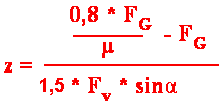
1,5 factor = if the lashing angle has μ 90° then the belt is pulling down the load with 1,5 times prestressing force on the loading platform. For FV you should insert the number /value indicated on the belt label STF (Standard Tension Force).
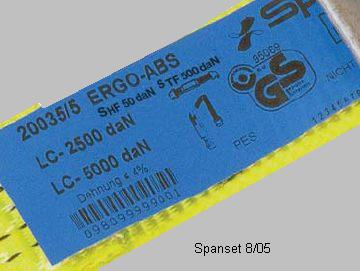
pulling down angle =
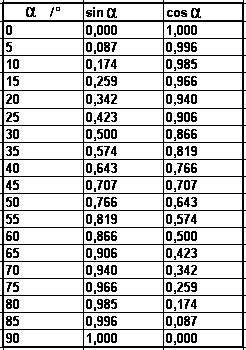 |
1. Example | 2. Example |
Given: Weight of the load m = 12,7t | Given: Weight of the load m = 12,7t |
Looking for: Required number of safety belts z | Looking for: Required number of safety belts z |
Lösung: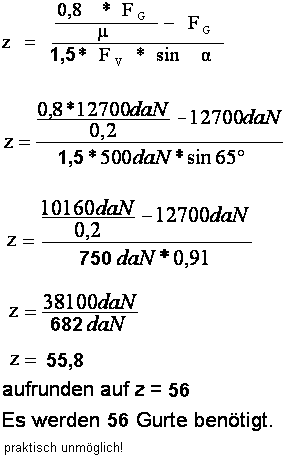 | Lösung: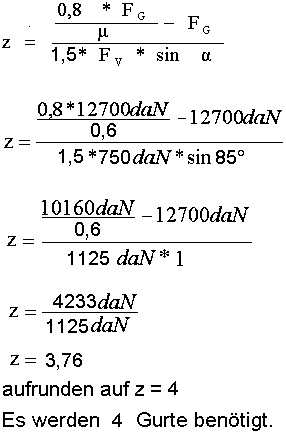 |
Result :Result:
z= 55,8 round it up to z = 56 z= 3,76 round it up to z= 4
It will be needed 56 belts in order to secure the load.It will be needed 4 belts in order to secure the load.
Practically impossible!
Here a simple chart which shows the pulling down force in view how many safety belts might be needed:
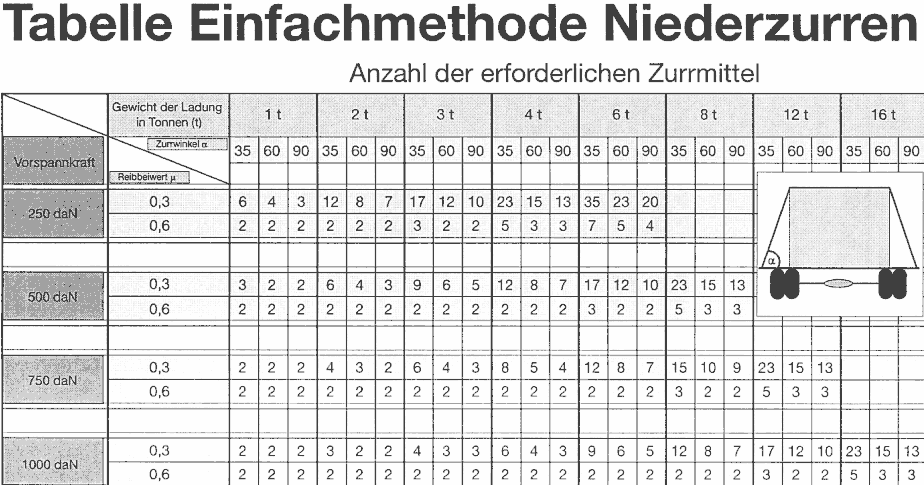
Source:
URL:http://www.google.de/imgres?imgurl=http://www.fahrzeug-elektrik.de/irjab.gif&imgrefurl=http://www.fahrzeug-elektrik.de/Erja.htm&h=485&w=924&sz=61&tbnid=ls4NUzjC_9VdiM:&tbnh=66&tbnw=125&prev=/search%3Fq%3Dniederzurren%2Bberechnung%26tbm%3Disch%26tbo%3Du&zoom=1&q=niederzurren+berechnung&usg=__aHIieG4udUrRnbuiP8au92hp2LQ=&docid=MODgnSSTZLSRWM&sa=X&ei=yznyUYvBN4iYtQbKpoCQCA&ved=0CFMQ9QEwBg&dur=868
The content and technical details are without warranty. (Source see source index)
